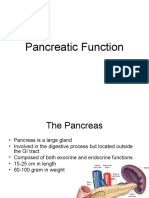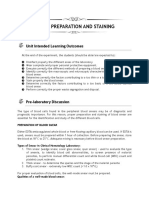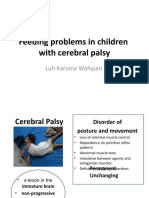8 Acid Fast Staining Procedure 1
8 Acid Fast Staining Procedure 1
Uploaded by
Putri Senna RahayuCopyright:
Available Formats
8 Acid Fast Staining Procedure 1
8 Acid Fast Staining Procedure 1
Uploaded by
Putri Senna RahayuOriginal Description:
Copyright
Available Formats
Share this document
Did you find this document useful?
Is this content inappropriate?
Copyright:
Available Formats
8 Acid Fast Staining Procedure 1
8 Acid Fast Staining Procedure 1
Uploaded by
Putri Senna RahayuCopyright:
Available Formats
zACID FAST STAINING PROCEDURE
Dr. Sunarjati Sudigdo Adi, dr. MS., SpMK(K) I. General objective After finishing skill practice of this session, the student will be able to perform ZiehlNeelsen staining procedure from the sputum specimen Specific objective At the end of skill practice, student could interpret the result of Ziehl-Neelsen staining Methods a. Presentation b. Demonstration c. Coaching d. Self practice List of equipments, materials, and reagents Equipments & materials Sputum specimen Sputum container Bunsen burner Lighter/ matches Cotton soak with 95% alcohol Glass slides Pencil glass/ marking pen Sputum smear preparation positive AFB (not stained) Inoculating loop Filter/ tissue paper Sands with 70% alcohol Methanol 96% (spiritus) Toothpicks Slide holder or box Microscope Iron stick with cotton Reagents Carbol fuchsin (the Primary Stain) Decolorizer HCl 3%+alcohol 95% Methylene blue (the Counterstain) Water (preferably in a squirt bottle)/ tap water Oil emersion
II. III.
IV.
LEARNING GUIDE No 01. 02. 03. 04. 05. STEP SMEAR PREPARATION Clean glass slide by wiping it with wet cotton ball 95 % alcohol and/ or flame directly 2 3 times over the fire to make the slide fat free Mark a target oval area about 2x3 cm below the glass slide with a marking pen/ pencil glass Flame a bacteriological loop to get red-hot and the loop become sterile. Let it cool at room temperature WITHOUT touching anything. Open the sputum container carefully and place the lid face up on the work surface Dip the loop into a sputum sample, select the best portion of sputum, select the most purulent (the thickest part) of the sputum or bloodstained particles if present 0 1 2
06
Place the loop full of sample in the center of target area.
07 08
RESEAL the sputum container tightly Dips the loop into the bottle contains sands with 70 % alcohol, moves the loop up and down, and rotates in the sands. Reflame the loop and let cool and put it in the rack
09.
Using a toothpick smear the specimen with coiling methods. Spread the specimen using a toothpick vertically and horizontally and smear the specimen in small circular motions to distribute the specimen evenly until about 2x3 cm in size.
10. 11
DISCARD the applicator stick into a discard container containing sands and suitable disinfectant (alcohol 70%) ALLOW the smear to air dry completely at room temperature
12.
Fixation: Pass bottom part of the slide through the flame of a Bunsen burner 3-4 times but dont get burned the smear is now ready for staining procedure.
This process kills the bacteria and fixes them to the slide so they won't wash off during staining or rinsing.
01 02.
Ziehl-Neelsen staining procedure STEP 1: After fixation of the slides, place the fixed slide on the staining rack with the smeared side facing upwards STEP 2: Flood the entire slide with Carbol Fuchsin Ensure enough stain is added to keep the slides covered throughout the entire staining step
03.
STEP 3: Using a Bunsen burner or iron stick with cotton, heat the slides slowly until they are steaming. Maintain steaming for 5 minutes by using low or intermittent heat (i.e. by occasionally passing the flame from the Bunsen burner under the slides), prevent the stain for boiling. Allow the slide to cool for 30-60 seconds Caution: Using too much flame or heat can cause the slide to break.
STEP 4: Gently rinse the slide with tap water to remove the excess carbol fuchsin stain. At this point, the smear on the slide looks red in color.
STEP 5: Decolorize the slide by dip it into 3% chloric acid-95% alcohol for few seconds until the slides are clear of stain visible to the naked eye.
To the right are examples of slides insufficiently and sufficiently flooded with acid-alcohol.
STEP 6: Rinse the slide thoroughly with water and then drain any excess from the slides
STEP 7: Flood the slide with the counterstain, Methylene Blue. Keep the counterstain on the slides for 1 minute.
STEP 8: Rinse the slide thoroughly with water
STEP 9: let it dry at room temperature or dry it by blotting with filter/ tissue paper (do not rub!!)
Interpretation Morphological Characteristics - Acid-fast bacilli range from 1 to 10 m in length and 0.2 to 0.6 m in width. - They typically appear as slender, rod-shaped bacilli, but they may appear curved or bent. - Individual bacteria may display heavily stained area referred to as beads and areas of alternating stain producing a banded appearance. - Some mycobacteria other than M. tuberculosis may appear pleomorphic, ranging in appearance from long slender rods to coccoid forms, with more uniform distribution of staining properties. Method of Examination Ziehl-Neelsen stained smears should be examined with a 100x oil immersion objective.
Procedure of microscopy: Switch the lamp of microscope on Open diaphragm maximally Adjust the condenser up maximally Put the slide on the stage Put 1 drop of emersion oil Use 100 x objective lens turn until it touch the slide Turn coarse adjustment knob until you find the field Turn fine adjustment knob to set the focus of your eyes Start to count the bacteria Reporting Results of Acid-Fast Bacilli Smears One reporting system recommended by the International Union against Tuberculosis and Lung Disease (IUATLD) when reporting ZN stained smears observed at 1000x is: 1. AFB not found in 100 HPF : negative 2. 1 9 AFB/ 100 HPF : report the number of bacteria 3. 10 99 AFB/ 100 HPF : + or +1 4. 1 10 AFB/ 1 HPF: ++ or +2 5. > 10 AFB / 1 HPF: +++ or +3 Note : if 1 3 AFB/ 100 HPF, repeat exam using new specimen, if still 1 3 report as neg, if 4 9 report as pos.
Note: 0 = not doing at all 1 = do the step partially 2 = do the step completely
You might also like
- Fletcher Bolter Op ManualDocument56 pagesFletcher Bolter Op Manualbannet100% (1)
- Divinylbenzene Storage, Handling and SafetyDocument19 pagesDivinylbenzene Storage, Handling and SafetyMehul DeshpandeNo ratings yet
- Indian Beer MarketDocument15 pagesIndian Beer MarketRajeev NairNo ratings yet
- Acid Fast StainingDocument2 pagesAcid Fast StainingDixie DumagpiNo ratings yet
- Prothrombin Time (PT) PDFDocument3 pagesProthrombin Time (PT) PDFbongbongz8646100% (2)
- Giardia PPT M.SC Medical 4th SemDocument16 pagesGiardia PPT M.SC Medical 4th SemRahul ChaudharyNo ratings yet
- Bleeding Time, Clotting Time, PT, Aptt, Platelet IndicesDocument59 pagesBleeding Time, Clotting Time, PT, Aptt, Platelet Indicespriya madhooliNo ratings yet
- Estimation of AlbuminDocument2 pagesEstimation of AlbuminAnand VeerananNo ratings yet
- 3 Chemical Examination of UrineDocument82 pages3 Chemical Examination of UrineJake Real Dela Roca100% (1)
- Cytology Project in 18 PageDocument17 pagesCytology Project in 18 PageAnil Amrawanshi67% (3)
- Mycology: Specimen Collection & HandlingDocument46 pagesMycology: Specimen Collection & Handlingbetty kassawNo ratings yet
- ShigellaDocument23 pagesShigellaAayush AdhikariNo ratings yet
- Pancreas Function MazenDocument15 pagesPancreas Function MazenAhmed GaberNo ratings yet
- Semen Analysis (Seminal Cytology, Sperm CountDocument30 pagesSemen Analysis (Seminal Cytology, Sperm Countabdurae100% (1)
- Smear Preparation and Staining: Unit Intended Learning OutcomesDocument5 pagesSmear Preparation and Staining: Unit Intended Learning OutcomesPauline CabreraNo ratings yet
- White Blood Cell (WBCS) Count: Practical Hematology LabDocument20 pagesWhite Blood Cell (WBCS) Count: Practical Hematology LabNikhil DeshwalNo ratings yet
- Histopathologic Techniques by Gregorios Pages 257 269Document13 pagesHistopathologic Techniques by Gregorios Pages 257 269Desirie Rose LopenaNo ratings yet
- FixativesDocument11 pagesFixativeshenryjack1100% (1)
- Culture Bacterial Media Methods by Conventional Automated NotesDocument12 pagesCulture Bacterial Media Methods by Conventional Automated NoteskontamuruNo ratings yet
- Blood SmearDocument4 pagesBlood SmearHussein AlaNo ratings yet
- Differential Diagnosis of Malaria ParasiteDocument101 pagesDifferential Diagnosis of Malaria ParasiteSohaib Omer Salih100% (1)
- Lab Diagnosis of TBDocument73 pagesLab Diagnosis of TBMigori ArtNo ratings yet
- Urease Test - Principle, Media, Procedure and ResultDocument11 pagesUrease Test - Principle, Media, Procedure and ResultAlisha KhanNo ratings yet
- Lab Physiology Second Year PracticalDocument21 pagesLab Physiology Second Year PracticalNona NonicaaNo ratings yet
- 5.0 LeukopoiesisDocument37 pages5.0 LeukopoiesisJunior SataNo ratings yet
- Urine Culture: D.M.M. LabDocument15 pagesUrine Culture: D.M.M. LabTomi RahmadaniNo ratings yet
- 01 Intro To CytologyDocument48 pages01 Intro To CytologyAkinbami OlorunnifemiNo ratings yet
- Agglutination Reaction JMHFHSDocument50 pagesAgglutination Reaction JMHFHSRajkishor YadavNo ratings yet
- L E CellDocument59 pagesL E CellAvi VermaNo ratings yet
- Histopath Topic 3 PrelimDocument103 pagesHistopath Topic 3 PrelimKatrina JornadalNo ratings yet
- Antigen - Antibody Reactions: Dr.D.BinduDocument46 pagesAntigen - Antibody Reactions: Dr.D.Bindubindu dhanapalNo ratings yet
- Collection and Preservation of BloodDocument37 pagesCollection and Preservation of BloodSUSHMITHA PerumandalNo ratings yet
- Different Method of CBCDocument43 pagesDifferent Method of CBCArslan ArshadNo ratings yet
- Sputum AnalysisDocument12 pagesSputum AnalysisAdriana GarciaNo ratings yet
- Genpath-Group 4 (Staining of Lipids)Document19 pagesGenpath-Group 4 (Staining of Lipids)Iseth ISethNo ratings yet
- Tissue Processing: Department of Oral Pathology and MicrobiologyDocument106 pagesTissue Processing: Department of Oral Pathology and Microbiologyvinamr chopraNo ratings yet
- Errors in Tissue ProcessingDocument33 pagesErrors in Tissue ProcessingitsshaswatNo ratings yet
- Hem Lab3 Blood Smears F10Document10 pagesHem Lab3 Blood Smears F10Luke Hsu0% (1)
- Clinical Chemistry PPT LS 2Document19 pagesClinical Chemistry PPT LS 2Devvi Riasari BunardiNo ratings yet
- Platelet Function TestsDocument27 pagesPlatelet Function TestsTusabe FredNo ratings yet
- Lecture Notes in Medical Technology - Lecture #5 - THYROID FUNCTION TESTSDocument14 pagesLecture Notes in Medical Technology - Lecture #5 - THYROID FUNCTION TESTSKat JornadalNo ratings yet
- Romanowsky, Automated, and Pearls StainingDocument4 pagesRomanowsky, Automated, and Pearls Stainingادم Prabowo100% (1)
- 2 Tissue ProcessingDocument27 pages2 Tissue ProcessingAbdul HafeezNo ratings yet
- MICROHEMATOCRITDocument19 pagesMICROHEMATOCRITNico LokoNo ratings yet
- Glucose Meter: Glucose FAD Ferrocene Ferrocene + ElectronDocument2 pagesGlucose Meter: Glucose FAD Ferrocene Ferrocene + ElectronmohanksebNo ratings yet
- Hema Ii Laboratory Week 7 - PT & PTT MethodsDocument37 pagesHema Ii Laboratory Week 7 - PT & PTT MethodsAl-hadad AndromacheNo ratings yet
- Coombs TestDocument11 pagesCoombs TestunilabreynosaNo ratings yet
- Blood Smear 2023 PDFDocument15 pagesBlood Smear 2023 PDFكرار 2No ratings yet
- 2.preparation and Staining of Thick and Thin BloodDocument31 pages2.preparation and Staining of Thick and Thin Bloodbudi darmantaNo ratings yet
- Fungus Slide Culture LabDocument3 pagesFungus Slide Culture LabNovia S. Amalina0% (1)
- Lesson-27 Quality Control in CytologyDocument5 pagesLesson-27 Quality Control in CytologySasa AbassNo ratings yet
- Urine AnalysisDocument69 pagesUrine AnalysisAffan ElahiNo ratings yet
- Quality Assurance IN Histopathology: QC Should Consider The Whole ProcessDocument38 pagesQuality Assurance IN Histopathology: QC Should Consider The Whole Processalrasheed2020100% (1)
- Sputum ExaminationDocument31 pagesSputum ExaminationMalliga Sundareshan100% (1)
- CSF and Other Body FluidsDocument9 pagesCSF and Other Body FluidsJobelle0% (1)
- Aubf Lab Types of Urine SpecimenDocument18 pagesAubf Lab Types of Urine SpecimenNerizaNo ratings yet
- Sop HematocritDocument1 pageSop HematocritStephanie Bautista Alcantara100% (1)
- URIC ACID LyphoDocument2 pagesURIC ACID LyphoDharmesh Patel50% (2)
- Absolute Eosinophil Count: Tolentino, Melanie D. Villanueva, Michal GDocument16 pagesAbsolute Eosinophil Count: Tolentino, Melanie D. Villanueva, Michal GMichal VillanuevaNo ratings yet
- Examination of Specimens For ParasitesDocument32 pagesExamination of Specimens For ParasitesJhost Clinton PurbaNo ratings yet
- Materials Required:: ReagentsDocument3 pagesMaterials Required:: ReagentsmuhammadismailNo ratings yet
- A Guide To ZN StainingDocument2 pagesA Guide To ZN Stainingimran03027502006No ratings yet
- Anti-Epileptic Drugs: - Classification of SeizuresDocument31 pagesAnti-Epileptic Drugs: - Classification of SeizuresPutri Senna RahayuNo ratings yet
- Pid BSTDocument17 pagesPid BSTPutri Senna RahayuNo ratings yet
- Single-Dose Oral Phenytoin in GTC Status EpilepticusDocument19 pagesSingle-Dose Oral Phenytoin in GTC Status EpilepticusPutri Senna RahayuNo ratings yet
- Otitis Media KDDocument13 pagesOtitis Media KDPutri Senna RahayuNo ratings yet
- Palliative CarefinalDocument13 pagesPalliative CarefinalPutri Senna RahayuNo ratings yet
- The Family in Health and Disease: Dept. of Public Health & Preventive Medicine Faculty of Medicine Padjadjaran UniversityDocument25 pagesThe Family in Health and Disease: Dept. of Public Health & Preventive Medicine Faculty of Medicine Padjadjaran UniversityPutri Senna RahayuNo ratings yet
- The Family in Health and Disease: The Illness TrajectoryDocument20 pagesThe Family in Health and Disease: The Illness TrajectoryPutri Senna RahayuNo ratings yet
- Definition: - Causes:: Hypoxic Anaemic Stagnant HystotoxicDocument4 pagesDefinition: - Causes:: Hypoxic Anaemic Stagnant HystotoxicPutri Senna RahayuNo ratings yet
- Hypothesis Testing: Lab: Epidemiology and Biostatistics DepartmentDocument29 pagesHypothesis Testing: Lab: Epidemiology and Biostatistics DepartmentPutri Senna RahayuNo ratings yet
- Standard Precaution: Prof. Dr. Ida Parwati, PHDDocument23 pagesStandard Precaution: Prof. Dr. Ida Parwati, PHDPutri Senna Rahayu100% (2)
- Stool Analysis and Other Body Fluid AnalysisDocument51 pagesStool Analysis and Other Body Fluid AnalysisPutri Senna Rahayu100% (2)
- Sensus WP Dynamic KatalogDocument4 pagesSensus WP Dynamic Katalogdausdti 2021No ratings yet
- Select Model:: SB20-03 SB20-01 Index CSB19-06Document5 pagesSelect Model:: SB20-03 SB20-01 Index CSB19-06Teo DazaNo ratings yet
- Assignment 1Document11 pagesAssignment 1th015w65866637No ratings yet
- Cma Ubdhh 6518 E2-10 Pa5Document1 pageCma Ubdhh 6518 E2-10 Pa5michele DSNo ratings yet
- Africa Art .SculpturesDocument18 pagesAfrica Art .SculpturesAdelyen justinNo ratings yet
- Unseen PartnerDocument1 pageUnseen PartnerProcalimersNo ratings yet
- Gas Calibration Method v2Document9 pagesGas Calibration Method v2Mazhar MahadzirNo ratings yet
- Hydraulics and HydrologyDocument24 pagesHydraulics and HydrologyAkanji Emmanuel OjoNo ratings yet
- easson-es-8a-2x_techincalDocument2 pageseasson-es-8a-2x_techincalergincetinNo ratings yet
- SopManual HD255-5 PDFDocument975 pagesSopManual HD255-5 PDFQuy Le ThanhNo ratings yet
- 512 - 882493 - FEASIBILITY STUDY MODULE 10 - TECHNICAL or PRODUCTION FEASIBILITYDocument21 pages512 - 882493 - FEASIBILITY STUDY MODULE 10 - TECHNICAL or PRODUCTION FEASIBILITYApril Mae TrinidadNo ratings yet
- Improved Syntheses of Peptide Coupling Reagents Bop and Pybop Using TriphosgeneDocument5 pagesImproved Syntheses of Peptide Coupling Reagents Bop and Pybop Using TriphosgeneSulthon Rizki F. AzharNo ratings yet
- ELEMENT 11 Electricity2Document11 pagesELEMENT 11 Electricity2mano chandranNo ratings yet
- Group 2 - L2 - ManuscriptDocument5 pagesGroup 2 - L2 - ManuscriptAriff HaiqalNo ratings yet
- LPC2148 WatchdogtimerDocument10 pagesLPC2148 WatchdogtimerSania KawadeNo ratings yet
- NDT Eddy CurrentsDocument13 pagesNDT Eddy Currentsyashwant verma100% (1)
- SITXWHS007 Assessment 2 - ProjectDocument27 pagesSITXWHS007 Assessment 2 - Projectlouisa426wongNo ratings yet
- Speaker: Engr. Merlito Castor Catolico: PRC Accredited Speaker No. 071 Real Estate Broker/Appraiser /consultantDocument58 pagesSpeaker: Engr. Merlito Castor Catolico: PRC Accredited Speaker No. 071 Real Estate Broker/Appraiser /consultantLimuel Richa Paghubasan TrangiaNo ratings yet
- Automatically Generated VLSI Memory (December 2003) : Allen TANNER, Jerry TAN, and Scott HOLMESDocument10 pagesAutomatically Generated VLSI Memory (December 2003) : Allen TANNER, Jerry TAN, and Scott HOLMESPraveen NagaretnamNo ratings yet
- Factsheet NIFTY LargeMidcap 250 IndexDocument2 pagesFactsheet NIFTY LargeMidcap 250 IndexRahul RanjanNo ratings yet
- 5299 BudgeDocument24 pages5299 BudgeGavin BudgeNo ratings yet
- Feeding CP PIR Solo 190113Document19 pagesFeeding CP PIR Solo 190113lomalinda biancaNo ratings yet
- CAPE Chemistry Data BookletDocument5 pagesCAPE Chemistry Data BookletAnvitha PanyamNo ratings yet
- Chapter 31Document20 pagesChapter 318angeldoll8No ratings yet
- 11th Science Perfect Chemistry I Maharashtra BoardDocument9 pages11th Science Perfect Chemistry I Maharashtra Boardomambekar2007No ratings yet
- Food Manual 10.12 FinalDocument62 pagesFood Manual 10.12 FinalNeon GNo ratings yet
- RETANING WALLS Reading and Examples 1Document27 pagesRETANING WALLS Reading and Examples 1raunak .comNo ratings yet




































































































